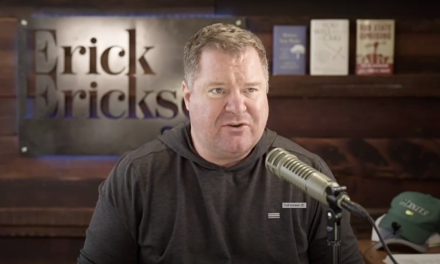We support our Publishers and Content Creators. You can view this story on their website by CLICKING HERE.
Along with my co-plaintiffs, I was at the Supreme Court last week for oral arguments in our Murthy v. Missouri case, in which we are challenging the federal government’s alleged censorship on social media. The Supreme Court will likely rule in June whether to uphold, modify, or strike down the Fifth Circuit Court of Appeals’ injunction against five federal agencies, in what, the district court judge wrote, “arguably involves the most massive attack against free speech in United States’ history.”
At the hearing, Justice Samuel Alito pointed out that emails between the White House and Facebook “showed constant pestering of Facebook.” He went on to comment, “I cannot imagine federal officials taking this approach to the print media. … It’s treating these platforms like subordinates.” He then asked the government’s attorney, “Would you treat The New York Times or The Wall Street Journal this way? Do you think the print media considers themselves ‘partners’ with government? I can’t imagine the federal government doing that to them.”
The government’s attorney had to admit, “The anger is unusual” — referring to White House official Rob Flaherty literally cursing at a Facebook executive and berating him for not taking action quickly enough to comply with the government’s censorship demands.
Justice Brett Kavanaugh followed up, asking, “On the anger point, do you think federal government officials regularly call up journalists and berate them?” It’s worth recalling that Kavanaugh worked as a White House attorney before he was appointed to the court, as did Justices John Roberts and Elena Kagan. No doubt there were times they dialed a journalist or editor to try to convince them to change a story, clarify a factual assertion, or even hold or quash the publication of a piece. Kavanaugh admitted, “It’s not unusual for the government to claim national security or wartime necessity to suppress a story.”
Perhaps colorful language is sometimes used in these conversations, as Kavanaugh himself hinted. Kagan concurred: “Like Justice Kavanaugh, I have had some experience encouraging the press to suppress its own speech. … This happens literally thousands of times a day in the federal government.” With a wink to the other former executive branch attorneys on the bench, Roberts quipped, “I have no experience coercing anyone,” which generated a rare chuckle from the bench and audience.
This analogy to government interactions with print media, however, does not hold in the case of the government’s relationship with social media. There are several crucial differences that profoundly change the power dynamic of those interactions in ways directly relevant to our case. These differences facilitate, in Alito’s words, the government treating the platforms like subordinates in ways that would be impossible with print media.
Behind the Scenes
First, when a government official contacts a newspaper, he is talking directly to the journalist or editor — the person whose speech he is trying to alter or curtail. The writer or editor has the freedom to say, “I see your point, so I’ll hold my story for one week to allow the CIA time to get their spies out of Afghanistan.” But the speaker also has the freedom to say, “Nice try, but I’m not persuaded I got the facts wrong on this, so I’m running the story.” The publisher here has the power, and there is little the government can do to threaten that power.
By contrast, with requests or demands for social media censorship, the government was never talking with the person whose speech was censored, but with a third party operating entirely behind the scenes. As my co-plaintiff, the eminent epidemiologist Dr. Martin Kulldorff, quipped, “I would have been happy to get a call from a government official and hear about why I should take down a post or change my views on the scientific evidence.”
Power Dynamic
Additionally, there is little the government can do to destroy the business model and cripple The New York Times or Wall Street Journal, and the journalists and editors know this. If the government pushes too hard, it will also be front page news the next day: “Government Trying to Bully The Post to Censor Our Breaking Story,” with the lede, “Naturally, we told them to go pound sand.”
But the power dynamic is entirely different with Facebook, Google, and X (formerly Twitter): The government does have a sword of Damocles to hang over the head of noncompliant social media companies if they refuse to censor — in fact, several swords, including the threat to remove Section 230 liability protections, which Facebook founder Mark Zuckerberg has accurately called an “existential threat” to their business, or threats to break up their monopolies. As the record in our lawsuit shows, the government explicitly made just such threats, even publicly on several occasions, in direct connection to their censorship demands.
Furthermore, unlike the major tech companies, newspapers or magazines do not have massive government contracts that might disappear if they refuse to comply. When the FBI or Department of Homeland Security calls Facebook or X with censorship demands, the corporate executives know that a weaponized agency has the power to launch frivolous but onerous investigations at any time. It thus becomes virtually impossible for social media companies to tell the government to take a hike — indeed, they may have a fiduciary duty to shareholders not to incur serious risks by resisting government pressure.
The text of the First Amendment doesn’t say the government shall not “prevent” or “forbid” free speech; it says the government shall not “abridge” free speech — i.e., shall not do anything to lesson a citizen’s ability to speak or diminish one’s potential reach. A sensible and clear injunction would simply state, “Government shall not request that social media companies remove or suppress legal speech.”
But if the justices want to distinguish between persuasion and coercion in the injunction, they need to appreciate that social media companies operate in a very different relationship with government than traditional print media. These asymmetrical power dynamics create a relationship ripe for unconstitutional government coercion.
Aaron Kheriaty, MD, is director of the Bioethics and American Democracy Program at the Ethics and Public Policy Center.

 Conservative
Conservative  Search
Search Trending
Trending Current News
Current News 





